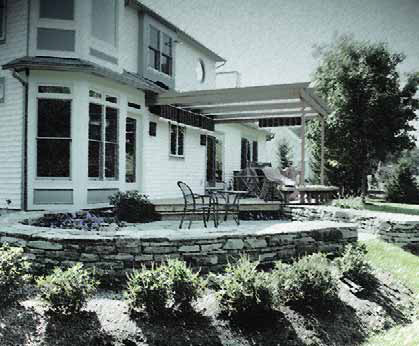ARTICLES
Advance Search
Aquatic Health
Aquatic Health, Fitness & Safety
Around the Internet
Aquatic Culture
Aquatic Technology
Artful Endeavors
Celebrity Corner
Life Aquatic
Must-See Watershapes
People with Cameras
Watershapes in the Headlines
Art/Architectural History
Book & Media Reviews
Commentaries, Interviews & Profiles
Concrete Science
Environment
Fountains
Geotechnical
Join the Dialogue
Landscape, Plants, Hardscape & Decks
Lighter Side
Ripples
Test Your Knowledge
The Aquatic Quiz
Other Waterfeatures (from birdbaths to lakes)
Outdoor Living, Fire Features, Amenities & Lighting
Plants
Ponds, Streams & Waterfalls
Pools & Spas
Professional Watershaping
Structures (Editor's Notes)
Travelogues & History
Water Chemistry
WaterShapes TV
WaterShapes World Blog
Web Links
Around the Internet
Aquatic Culture
Aquatic Technology
Artful Endeavors
Celebrity Corner
Life Aquatic
Must-See Watershapes
People with Cameras
Watershapes in the Headlines
I've always believed that an unlimited budget is not essential to making design magic. While having clients with deep pockets and a willingness to dig deeply into them is always nice and allows us a bit more leeway when it comes to artistic license, I've always observed that having relatively few constraints also tends to make some designers creatively lazy. By contrast, I've often found small-budget, small-space projects to be creatively stimulating. A couple of columns ago, for example, I discussed a project we'd been working on that posed challenges with its sunken deck footings and the need to accomplish a lot with
I've always believed that an unlimited budget is not essential to making design magic. While having clients with deep pockets and a willingness to dig deeply into them is always nice and allows us a bit more leeway when it comes to artistic license, I've always observed that having relatively few constraints also tends to make some designers creatively lazy. By contrast, I've often found small-budget, small-space projects to be creatively stimulating. A couple of columns ago, for example, I discussed a project we'd been working on that posed challenges with its sunken deck footings and the need to accomplish a lot with
I've written several times in the past about the fact that more and more landscape architects and designers are getting into watershaping. As evidence, all you need to do is look at design-award competitions in the pool and spa industry and note the increasing number of submissions from landscape professionals: It's even getting to the point in some programs where they're outnumbering participants who come from the traditional pool and spa industry. You'll find even more evidence of this phenomenon on the web sites of landscape-focused companies, where you'll see watershapes of all shapes and descriptions in most of their photo galleries. Moreover, many I know in the pool and spa industry have had the experience of
I've written several times in the past about the fact that more and more landscape architects and designers are getting into watershaping. As evidence, all you need to do is look at design-award competitions in the pool and spa industry and note the increasing number of submissions from landscape professionals: It's even getting to the point in some programs where they're outnumbering participants who come from the traditional pool and spa industry. You'll find even more evidence of this phenomenon on the web sites of landscape-focused companies, where you'll see watershapes of all shapes and descriptions in most of their photo galleries. Moreover, many I know in the pool and spa industry have had the experience of
For years now, the power of teamwork and the communication it requires have been recurring, primary themes in the pages of WaterShapes. It's no secret that, more than ever before, the design, engineering and construction of custom watershapes of all sorts is a multi-disciplinary undertaking that involves
For years now, the power of teamwork and the communication it requires have been recurring, primary themes in the pages of WaterShapes. It's no secret that, more than ever before, the design, engineering and construction of custom watershapes of all sorts is a multi-disciplinary undertaking that involves
Throughout ancient times, water was central to the thinking of Arab, Persian, Moorish, Moghul and Turkish architects and designers, with largely anonymous representatives of each civilization preparing elaborate spaces with fountains, reflecting pools and other watershapes at their hearts. In the past, these societies' greatest architectural works almost invariably featured elaborate watershapes that bespoke their technical skills as well as a general love affair with the beauty, luxury and necessity of water. With new developments burgeoning across much of the Middle East these days, fountains and watershapes of all varieties are once again playing important roles in design as
Throughout ancient times, water was central to the thinking of Arab, Persian, Moorish, Moghul and Turkish architects and designers, with largely anonymous representatives of each civilization preparing elaborate spaces with fountains, reflecting pools and other watershapes at their hearts. In the past, these societies' greatest architectural works almost invariably featured elaborate watershapes that bespoke their technical skills as well as a general love affair with the beauty, luxury and necessity of water. With new developments burgeoning across much of the Middle East these days, fountains and watershapes of all varieties are once again playing important roles in design as
To the casual observer, it might seem that what we do is all about artificial rock. But if you look closer, I think a better description is that we work in the business of "themed construction." While much of our work centers on the creative use of artificial rock, we do much more than shape that raw material in fashioning the archaeological replicas, exotic watershapes, zoological exhibits and grand-scale sculptures of which the rockwork is a part. As we see it, what we do is develop whatever sort of tableau a client might want in whatever media might help us capture it. As a consequence, our work at The Lakeland Co. (Rathdrum, Idaho) has brought us into contact with an incredibly broad spectrum of projects in a wide range of settings, from
To the casual observer, it might seem that what we do is all about artificial rock. But if you look closer, I think a better description is that we work in the business of "themed construction." While much of our work centers on the creative use of artificial rock, we do much more than shape that raw material in fashioning the archaeological replicas, exotic watershapes, zoological exhibits and grand-scale sculptures of which the rockwork is a part. As we see it, what we do is develop whatever sort of tableau a client might want in whatever media might help us capture it. As a consequence, our work at The Lakeland Co. (Rathdrum, Idaho) has brought us into contact with an incredibly broad spectrum of projects in a wide range of settings, from

















